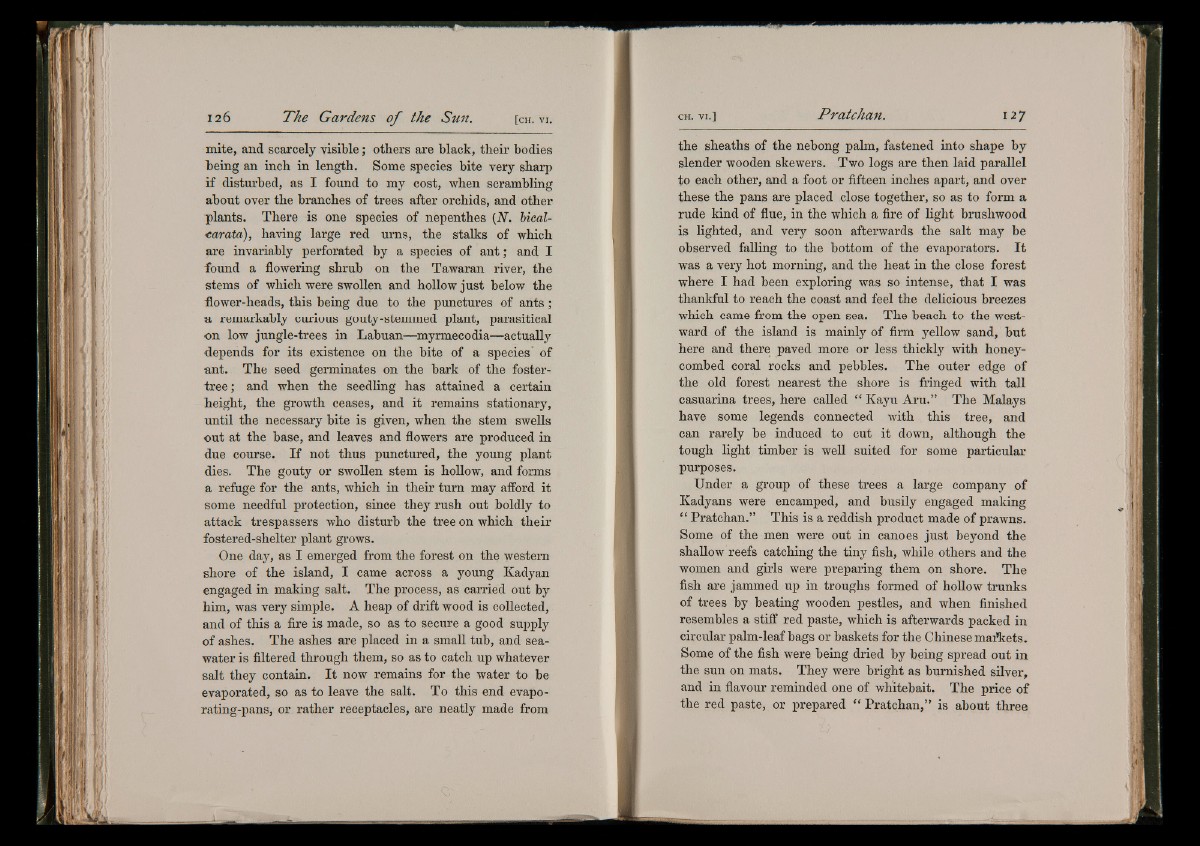
mite, and scarcely visible; others are black, their bodies
being an inch in length. Some species bite very sharp
if disturbed, as I found to my cost, when scrambling
about over the branches of trees after orchids, and other
plants. There is one species of nepenthes {N. bical-
■carata), having large red urns, the stalks of which
are invariably perforated by a species of an t; and I
found a flowering shrub on the Tawaran river, the
stems of which were swollen and hollow just below the
flower-heads, this being due to the punctures of ants;
a remarkably curious gouty-stemmed plant, parasitical
on low jungle-trees in Labuan—myrmecodia—actually
depends for its existence on the bite of a species' of
ant. The seed germinates on the bark of the fostertree;
and when the seedling has attained a certain
height, the growth ceases, and it remains stationary,
until the necessary bite is given, when the stem swells
out at the base, and leaves and flowers are produced in
due course. I f not thus punctured, the young plant
dies. The gouty or swollen stem is hollow, and forms
a refuge for the ants, which in their turn may afford it
some needful protection, since they rush out boldly to
attack trespassers who disturb the tree on which their
fostered-shelter plant grows.
One day, as I emerged from the forest on the western
shore of the island, I came across a young Kadyan
engaged in making salt. The process, as carried out by
him, was very simple. A heap of drift wood is collected,
and of this a fire is made, so as to secure a good supply
of ashes. The ashes are placed in a small tub, and seawater
is filtered through them, so as to catch up whatever
salt they contain. It now remains for the water to be
evaporated, so as to leave the salt. To this end evapo-
rating-pans, or rather receptacles, are neatly made from
the sheaths of the nebong palm, fastened into shape by
slender wooden skewers. Two logs are then laid parallel
to each other, and a foot or fifteen inches apart, and over
these the pans are placed close together, so as to form a
rude kind of flue, in the which a fire of light brushwood
is lighted, and very soon afterwards the salt may be
observed falling to the bottom of the evaporators. It
was a very hot morning, and the heat in the close forest
where I had been exploring was so intense, that I was
thankful to reach the coast and feel the delicious breezes
which came from the open sea. The beach to the westward
of the island is mainly of firm yellow sand, but
here and there paved more or less thickly with honeycombed
coral rocks and pebbles. The outer edge of
the old forest nearest the shore is fringed with tall
casuarina trees, here called “ Kayu Aru.” The Malays
have some legends connected with this tree, and
can rarely be induced to cut it down, although the
tough light timber is well suited for some particular
purposes.
Under a group of these trees a large company of
Kadyans were encamped, and busily engaged m a k in g
“ Pratchan.” This is a reddish product made of prawns.
Some of the men were out in canoes just beyond the
shallow reefs catching the tiny fish, while others and the
women and girls were preparing them on shore. The
fish are jammed up in troughs formed of hollow trunks
of trees by beating wooden pestles, and when finished
resembles a stiff red paste, which is afterwards packed in
circular palm-leaf bags or baskets for the Chinese mafkets.
Some of the fish were being dried by being spread out in
the sun on mats. They were bright as burnished silver,
and in flavour reminded one of whitebait. The price of
the red paste, or prepared “ Pratchan,” is about three